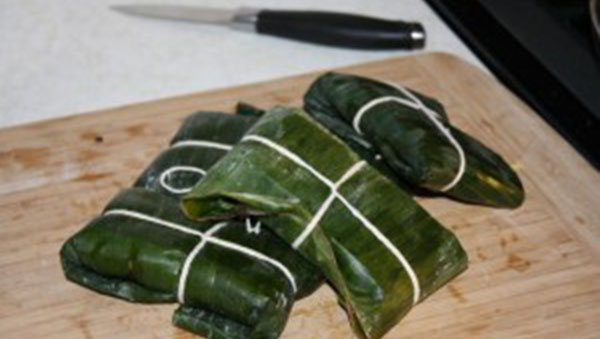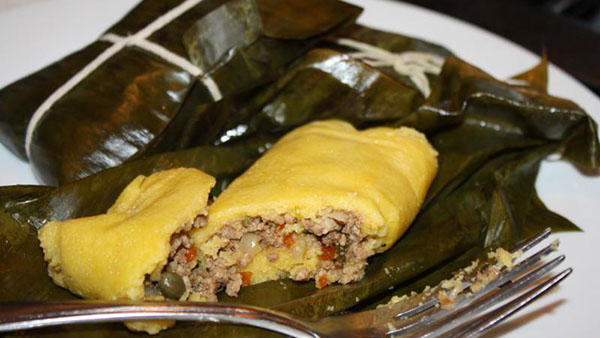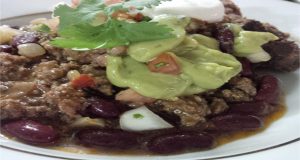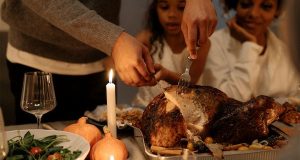By Chris De La Rosa
PRIDE Cuisine Specialist
 Growing up on the islands pastelles were not on our hit-list for Christmas, as it wasn’t something made by our mom or dad.
Growing up on the islands pastelles were not on our hit-list for Christmas, as it wasn’t something made by our mom or dad.
I do recall the lady who lived a couple houses across from us had a part-time job around the holiday season where she assisted in making pastelles by the hundreds and that’s pretty much all I knew about this tasty Christmas treat.
Made from beef, pork or chicken, I do crave pastelles in my adult days and it seems that by the number of requests I get every year for this recipe, it’s a must-have in many homes in Trinidad and Tobago.
Very similar to recipes made in Venezuela and Latin America, our pastelle is a true refection of the diverse culture we proudly claim in Trinbago. As there are many variations today and one could even find vegetarian editions being made by suppliers.
One of the problems I encounter as a cook/chef outside the islands, is sourcing the right ingredients. So in the recipe below you’ll see that I encountered a problem with the corn meal, but with some creativity I was able to correct and tweak things. I do hope you appreciate the creativity.
You’ll Need…
For the filling
1.5 lb mixed ground meat (pork | beef | veal)
2 onions, chopped
2 scallions
2 tablespoon thyme
1/2 habanero or scotch bonnet pepper
2 pimento peppers
2 cloves garlic
1 tsp black pepper
1 teaspoon salt
¼ cup ketchup
1 tsp Worcester sauce
3 tbsp capers (optional)
2 tbsp olives, chopped
½ cup raisins (I didn’t have any so I had to do without this time)
For the cornmeal outer layer
2 cups cornmeal (I see my note below)
3 cups lukewarm water
4 tbsp cooking oil
1 ¼ tsp salt
Banana leaves for wrapping and about 2 tablespoon veg oil for brushing the leaves.
Note 1: I like the rounded flavor and texture of using the mixed grounded meats I mentioned in the ingredients list. The traditional way is to use beef or pork and maybe chicken and it’s not common to mix the meats. Most people stick to one type of meat.
Note 2: I was lucky to find banana leaves in the freezer section at the Asian supermarket. If you can’t source banana leaves, feel free to use aluminum foil to wrap them in. You may also want to check with Latin grocery stores for the banana leaves as I know they use it in many of their recipes.
Note 3: In 95% of the recipes you’ll see online and in cookbooks you’ll notice that they call for corn meal, I strongly believe they mean to say corn flour as I was told on the Facebook fan page.
The first thing we’ll do is to prepare the filling since we must allow it to cool before we can proceed with actually making the pastelles. In a large sauce pan (no oil needed) add the ground meats and proceed to brown on a medium heat. Please use a wooden spoon (I find this works best) to continuously break up the meat as it cooks. We don’t want any large lumps.
As the meat cooks, lets prepare the other ingredients for adding to the filling mix. Chop the onion, garlic, peppers and scallion… give the olives and capers a rough chop as well.
 The ground meat should be fully cooked by now. I used lean ground meats so there’s residual fat in the pan. If you find that you have oil at the bottom of the pan, try to spoon it out. Now add the diced onion, garlic, peppers and scallion to the pan and on a low/med heat allow to cook until soft (about 3-4 minutes). Next up, add the capers and olives give it a good stir. Finally add the black pepper, ketchup, Worcester sauce and salt. If you have raisins, add them now as well. Allow this to cook for a couple minutes, then turn off the stove and allow to cool.
The ground meat should be fully cooked by now. I used lean ground meats so there’s residual fat in the pan. If you find that you have oil at the bottom of the pan, try to spoon it out. Now add the diced onion, garlic, peppers and scallion to the pan and on a low/med heat allow to cook until soft (about 3-4 minutes). Next up, add the capers and olives give it a good stir. Finally add the black pepper, ketchup, Worcester sauce and salt. If you have raisins, add them now as well. Allow this to cook for a couple minutes, then turn off the stove and allow to cool.
As the filling cools, lets work on the outer layer. Here’s where I ran into problems as the brand and texture of the corn meal I used wasn’t working for me. It was suggested by the group on Facebook, that I should use a brand called Promasa cornmeal flour.. next rongs I guess. Basically all you’re doing is in a large bowl, mix the water, corn meal flour, oil and salt to make a dough. After trying that I realize that the water and meal I was using was not binding. So I quickly placed it in a pot and on a low heat cooked it for a few minutes. But you must continuously stir.. that is if your corn meal gives problem as mine did. If you have the right corn foul as I suggested there’s no need for cooking as I did.
So after my issues with the dough.. I moved on. Make 12 equal balls with the dough, but as you make them.. be sure to cover with plastic wrap pr a damp tea towel or they will dry up.
Let’s prepare the green banana leaves for wrapping these packets of heaven. If you’re using fresh cut leaves you’ll have to pass them over an open flame to make them easier to work with. If not, they will not fold and will burst/crack on you. Since I was using frozen leaves which I found at the Asian store (also check Latin groceries as well) I didn’t have to pass them over any flame (make sure they’re thawed though). Cut them into 8 to 10 inch squares, wipe with a wet towel to clean off any residue and get ready to assemble.
I had a small bowl with vegetable oil and a brush handy. Brush some oil in the middle of each leaf, then place a ball of dough and worked it till I got a fairly large circle (make sure you have even thickness). If you have a tortilla press, it will make this step very easy for you. Now grab a heaping tablespoon (or more) of the cooled filling and place in the center. Using the sides of the leaf, fold until you get a small package (see video below). Now tie with some string and repeat for the rest of them.
You’ll find that some people choose to boil these, but I much prefer to have them steamed. Since I don’t own a steamer, I made one with what I already have. In a large pan, I put about 1-2 cups of water, brought that up to a boil, then placed a wire strainer on top (do not have the water touch the pastelles). I then I placed the uncooked pastelles on top, made sure the heat was set so I had a gentle simmer (to create steam) and I placed the laid of the pan over it to trap that steam. In the video below you’ll see what I mean. Steam for about 20-25 minutes and they should be fully cooked.
Well, after 20 minutes I was enjoying my pastelles with some good pepper sauce. If I find the time before Christmas, I’ll try to share a chow chow recipe with you all. That’s one of the main condiments to go with the foods we enjoy around the holidays.
This recipe is courtesy of Gourmand Award-winning cookbook author and founder of CaribbeanPot.com, Chris De La Rosa. With over 450 printable recipes with step by step cooking instructions and demo videos, plus over 1 million social/fan connections globally every month, CaribbeanPot.com is the world’s #1 resource of Caribbean Culinary Culture. Connect with Chris on Instagram: www.instagram.com/caribbeanpot/.
 Pride News Canada's Leader In African Canadian & Caribbean News, Views & Lifestyle
Pride News Canada's Leader In African Canadian & Caribbean News, Views & Lifestyle





